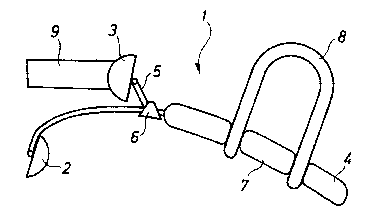Some of the information on this Web page has been provided by external sources. The Government of Canada is not responsible for the accuracy, reliability or currency of the information supplied by external sources. Users wishing to rely upon this information should consult directly with the source of the information. Content provided by external sources is not subject to official languages, privacy and accessibility requirements.
Any discrepancies in the text and image of the Claims and Abstract are due to differing posting times. Text of the Claims and Abstract are posted:
| (12) Patent Application: | (11) CA 2344062 |
|---|---|
| (54) English Title: | HALLUX VALGUS BRACE |
| (54) French Title: | ATTELLE POUR HALLUX VALGUS |
| Status: | Deemed Abandoned and Beyond the Period of Reinstatement - Pending Response to Notice of Disregarded Communication |
| (51) International Patent Classification (IPC): |
|
|---|---|
| (72) Inventors : |
|
| (73) Owners : |
|
| (71) Applicants : |
|
| (74) Agent: | SMART & BIGGAR LP |
| (74) Associate agent: | |
| (45) Issued: | |
| (86) PCT Filing Date: | 1999-09-15 |
| (87) Open to Public Inspection: | 2000-03-23 |
| Availability of licence: | N/A |
| Dedicated to the Public: | N/A |
| (25) Language of filing: | English |
| Patent Cooperation Treaty (PCT): | Yes |
|---|---|
| (86) PCT Filing Number: | PCT/SE1999/001608 |
| (87) International Publication Number: | WO 2000015163 |
| (85) National Entry: | 2001-03-14 |
| (30) Application Priority Data: | ||||||
|---|---|---|---|---|---|---|
|
The invention relates to a hallux valgus brace, i.e. a brace designed for
treatment of non-rigid hallux valgus. The brace comprises a three point lever
means for correcting the position of the big toe. According to the invention
the complete brace (1) is designed to be located distally of the metatarsal
joint. Preferably, the brace comprises a proximal pad (2) pressing on the
first phalanx of the big toe, a distal pad (3) pressing on the distal end of
the first phalanx of the big toe, and a lever arm (4) pressing on the ball of
the foot. The brace can be used during walking and other activities.
L'invention se rapporte à une attelle pour hallux valgus, c'est-à-dire une attelle conçue pour le traitement d'hallux valgus non rigide. Cette attelle comporte un organe à effet de levier en trois points qui permet de corriger la position du gros orteil. Conformément à cette invention, la totalité de l'attelle (1) est conçue pour être placée à distance de l'articulation métatarsienne. De préférence, cette attelle comporte un coussinet proximal (2) qui fait pression sur la première phalange du gros orteil, un coussinet distal (3) qui fait pression sur la partie distale de la première phalange du gros orteil et un bras de levier (4) qui fait pression sur l'extrémité antérieure de la plante du pied. Cette attelle peut être portée pour la marche et d'autres activités.
Note: Claims are shown in the official language in which they were submitted.
Note: Descriptions are shown in the official language in which they were submitted.

2024-08-01:As part of the Next Generation Patents (NGP) transition, the Canadian Patents Database (CPD) now contains a more detailed Event History, which replicates the Event Log of our new back-office solution.
Please note that "Inactive:" events refers to events no longer in use in our new back-office solution.
For a clearer understanding of the status of the application/patent presented on this page, the site Disclaimer , as well as the definitions for Patent , Event History , Maintenance Fee and Payment History should be consulted.
| Description | Date |
|---|---|
| Application Not Reinstated by Deadline | 2005-09-15 |
| Time Limit for Reversal Expired | 2005-09-15 |
| Inactive: IPRP received | 2004-11-04 |
| Inactive: Abandon-RFE+Late fee unpaid-Correspondence sent | 2004-09-15 |
| Deemed Abandoned - Failure to Respond to Maintenance Fee Notice | 2004-09-15 |
| Letter Sent | 2001-10-24 |
| Inactive: Single transfer | 2001-09-19 |
| Inactive: Cover page published | 2001-06-11 |
| Inactive: First IPC assigned | 2001-06-03 |
| Inactive: Courtesy letter - Evidence | 2001-05-29 |
| Inactive: Notice - National entry - No RFE | 2001-05-24 |
| Application Received - PCT | 2001-05-15 |
| Application Published (Open to Public Inspection) | 2000-03-23 |
| Abandonment Date | Reason | Reinstatement Date |
|---|---|---|
| 2004-09-15 |
The last payment was received on 2003-08-19
Note : If the full payment has not been received on or before the date indicated, a further fee may be required which may be one of the following
Please refer to the CIPO Patent Fees web page to see all current fee amounts.
| Fee Type | Anniversary Year | Due Date | Paid Date |
|---|---|---|---|
| Basic national fee - standard | 2001-03-14 | ||
| MF (application, 2nd anniv.) - standard | 02 | 2001-09-17 | 2001-09-07 |
| Registration of a document | 2001-09-19 | ||
| MF (application, 3rd anniv.) - standard | 03 | 2002-09-16 | 2002-08-23 |
| MF (application, 4th anniv.) - standard | 04 | 2003-09-15 | 2003-08-19 |
Note: Records showing the ownership history in alphabetical order.
| Current Owners on Record |
|---|
| CAMP SCANDINAVIA AB |
| Past Owners on Record |
|---|
| JAN SMITS |